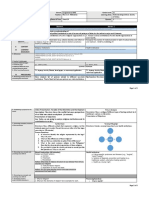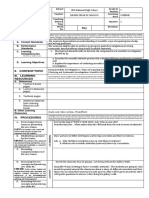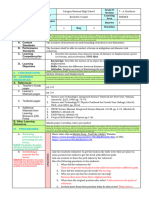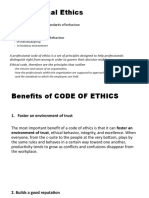Fil 11 - DLP
Fil 11 - DLP
Uploaded by
jovie nombradoCopyright:
Available Formats
Fil 11 - DLP
Fil 11 - DLP
Uploaded by
jovie nombradoOriginal Title
Copyright
Available Formats
Share this document
Did you find this document useful?
Is this content inappropriate?
Copyright:
Available Formats
Fil 11 - DLP
Fil 11 - DLP
Uploaded by
jovie nombradoCopyright:
Available Formats
School Grade &
SAN ROQUE NATIONAL HIGH SCHOOL 11-SOCRATES
Section
DAILY Teacher Learning Komunikasyon at
JOVIE B. NOMBRADO Area Pananaliksik sa Wika
LESSON at Kulturang Pilipino
PLAN Teaching Dates
3:00-4:00 MTWTH Quarter 4
& Time
Week No. 3 Day 5 Duration 1 hr.
Objectives must be met over the week and connected to the curriculum standards. To meet the objectives, necessary procedure must be followed and if needed,
additional lessons, exercises, remedial activities may be done for developing content knowledge and competencies. These are assessed using Formative
I. OBJECTIVES Assessment strategies. Valuing objectives support the learning of content and competencies and enable children to find significance and joy in learning the
lessons. Weekly objectives shall be derived from the curriculum guide.
Nauunawaan nang may masusing pagsasaalang-alang ang mga limgguwistiko at kultural na
A. Content
katangian at pagkakaiba-iba sa lipunang Pilipino at mga sitwasyon ng paggamit ng wika
Standards
dito.
B. Performance Nakagagawa ng mga pag-aaral ukol sa iba’t-ibang sitwasyon ng paggamit ng wikang Filipino
Standards sa loob ng kultura at lipunang Pilipino.
C. Learning 1.
Competency/ies
Write the LC Code for each.
Knowledge: Define neural network, social network, brain, and neuron
D. Learning Skills: Illustrate how the brain or neural network works.
Objectives Attitudes: Appreciate the significant roles within the community by creating a social
map of relationships.
Content is what the lesson all about. It pertains to the subject matter the teacher aims to teach in the CG, the content can be tackled in a week or two.
II. CONTENT/TOPIC NEURAL AND SOCIAL NETWORKS
III. LEARNING List the materials to be used in different days. Varied sources of materials sustain children’s interest in the lesson and learning. Ensure that there is a mix of
concrete and manipulative materials as well as paper-based materials. Hands-on learning promotes concept development.
RESOURCES
A. References
1. Teacher’s Guide
pages/Curriculum Refer to CG, page 4
Guide
2. Learner’s Materials
pages
3. Textbook pages Refer to pp. 118-122
4. Additional
Materials from
Learning Resource
(LR) Portal
B. Other Learning
http://natureofcode.com/book/chapter-10-neural-networks/
Resources
These steps should be across the week. Spread out the activities appropriately so that students will learn well. Always be guided by demonstration of learning by
the students which you can infer from formative assessment activities. Sustain learning systematically by providing students with multiple ways to learn new
IV. PROCEDURES things, practice their learning, question their learning processes, and draw conclusion about what they learned in relation to their life experiences and previous
knowledge. Indicate the time allotment for each step.
A. Reviewing previous Review: Recall concepts from the past lesson
lesson or
presenting the new Motivation: Let the learners watch some pictures flash on TV screen and let them
lesson. answer the following question.
ELICIT (The activities in this section will 1. Who are we? Why are we here?
evoke or draw out prior concepts of or 2. Why and how are we connected?
AWARENESS
experiences from the students)
B. Establishing a DEVELOPMENTAL ACTIVITY:
purpose for the Group the learners into four.
lesson. Let each group create a social map that traces the various roles you play in
ENGAGE (The activities in this section your community and rank the significance of the roles you play within your
will stimulate their thinking and help them community.
access and connect prior knowledge as a
jumpstart to the present lesson.)
C.Presenting Have each group choose a representative and let them explain and discuss their
examples/instances output in the class.
of the new lesson.
D. Discussing the new
concepts and The teacher then uses the Q & A method of discussion to make it more interesting and
practicing new engaging. The teacher presents the topic using powerpoint presentation.
skills #1.
EXPLORE (In this section, students
will be given time to think, plan,
ACTIVITY
investigate, and organize collected
information; or the performance of the
planned/prepared activities from the
student’s manual with data gathering and
Guide questions)
E. Discussing the new
concepts and Infusion of Values: An appreciation of the various roles that each of us plays in the
practicing new community such as being a family member, community leader, etc.)
skills #2.
F. Developing
mastery
GROUP ACTIVIT: Each group will be given a copy of the reading selection entitled
(Leads to formative
assessment 3). “Scientists Locate “Internal Compass” in the Brain”. Let them answer the following
ANALYSIS
EXPLAIN (In this section, students will
be involved in an analysis of their questions:
exploration. Their understanding is
clarified and modified because of
1. How is the “sense of direction” determined by the brain?
reflective activities)/Analysis of the 2. How does the “internal compass” readjust?
gathered data and results and be able to
answer the Guide Questions leading to 3. What is your entorhinal region?
the focus concept or topic of the day.
G. Making The teacher then expounds the discussion using powerpoint presentation.
generalization and
ABSTRACTION
abstraction about GENERALIZATION: The human brain can be described as a biological neural network-
the lesson. an interconnected web of neurons transmitting elaborate patterns of electrical signals.
ELABORATE (This section will give
students the opportunity to expand and
Dendrites receive input signals, and based on those inputs, fire an output signal via an
solidify / concretize their understanding of axon. How the human brain actually works is an elaborate and complex mystery.
the concept and / or apply it to real –
world situation)
H. Finding practical Let the learners formulate and raise questions regarding the lesson.
APPLICATION
application of
concepts and skills
in daily living.
I. Evaluating learning.
ASSESSMENT
EVALUATION (This section will Let the learners define the terms used in the lesson.
provide for concept check test items and 1. Neural network
answer key which are aligned to the
learning objectives - content and
2. Social network
performance standards and address 3. Brain
misconceptions – if any) 4. neuron
J. Additional
activities for Let each group research on the internet about Stephen Hawking and his works. let
ASSIGNMENT
application or them get a news clip about the brain function according to Stephen Hawking and how
remediation. Hawking viewed the human brain.
EXTEND (This sections give situation
that explains the topic in a new context ,
or integrate it to another discipline /
societal concern)
One objective of the lesson was not carried out because of limited time.
Continuation of the lesson will be done on the next day.
V. REMARKS
Reflect on your teaching and assess yourself as a teacher. Think about your students’ progress this week. What works? What else needs to be done to help the
VI. REFLECTION students learn? Identify what help your instructional supervisors can provide for you so when you meet them, you can ask them relevant question.
A. No. of learners who
earned 80% on the There were 25 learners who earned 80% on the formative assessment.
formative assessment
B. No. of learners who
require additional activities There were 10 learners who require additional activities for remediation.
for remediation
C. Did the remedial lesson
work? No. of learner who Yes. There were 7 learners who caught up with the lesson.
caught up with the lesson
D. No. of learner who
continue to require 5 learners require to continue remediation.
remediation
E. Which of my teaching
Group activities and using technology for the learners to really understand better the
strategies worked well?
lesson.
Why did these work?
F. What difficulties did I
Lack of learner’s material and reference books. Furthermore, the teacher is not a trained
encounter which my
senior high school teacher, thus, additional training and seminar is needed by the
principal or supervisor can
teacher.
help me solve?
You might also like
- Elec 4 Managing A Service Enterprise Syllabus100% (1)Elec 4 Managing A Service Enterprise Syllabus13 pages
- Primary Sources: Polybius - "A Remarkably Well-Informed, Industrious, and Insightful Historian"No ratings yetPrimary Sources: Polybius - "A Remarkably Well-Informed, Industrious, and Insightful Historian"7 pages
- Q4 COT MAPEH 10 - Health (Allied Medical Professions)No ratings yetQ4 COT MAPEH 10 - Health (Allied Medical Professions)5 pages
- Grade 1 To 12 Daily Lesson LOG Comprehensive High School Context (First Semester)No ratings yetGrade 1 To 12 Daily Lesson LOG Comprehensive High School Context (First Semester)3 pages
- Grade 1 To 12 Daily Lesson LOG Comprehensive High School Context (First Semester)No ratings yetGrade 1 To 12 Daily Lesson LOG Comprehensive High School Context (First Semester)3 pages
- Q1 COT - MAPEH 8 - Health 8 (Dimensions of Human Sexuality)No ratings yetQ1 COT - MAPEH 8 - Health 8 (Dimensions of Human Sexuality)4 pages
- Grade 1 To 12 Daily Lesson LOG Comprehensive High School Context (Second Semester)100% (1)Grade 1 To 12 Daily Lesson LOG Comprehensive High School Context (Second Semester)2 pages
- Grade 1 To 12 Daily Lesson LOG High School Sheila Lutero Week September 12 & 14, 2017 (Tuesday and Thursday/ 9:30-11:30a.m.)No ratings yetGrade 1 To 12 Daily Lesson LOG High School Sheila Lutero Week September 12 & 14, 2017 (Tuesday and Thursday/ 9:30-11:30a.m.)3 pages
- Grade 1 To 12 Daily Lesson LOG Comprehensive High School Sheila L. Lutero Context (First Semester)No ratings yetGrade 1 To 12 Daily Lesson LOG Comprehensive High School Sheila L. Lutero Context (First Semester)3 pages
- Grade 1 To 12 Daily Lesson LOG Comprehensive High School Context (First Semester)No ratings yetGrade 1 To 12 Daily Lesson LOG Comprehensive High School Context (First Semester)3 pages
- Q4 COT MAPEH 10 - PE (Hand Movement & Position in Cheer Dance)No ratings yetQ4 COT MAPEH 10 - PE (Hand Movement & Position in Cheer Dance)6 pages
- Carrying Capacity and Population GrowthNo ratings yetCarrying Capacity and Population Growth10 pages
- FILIPINO 7 - Mito ISANG MATANDANG KUBA SA GABI NG CAÑAONo ratings yetFILIPINO 7 - Mito ISANG MATANDANG KUBA SA GABI NG CAÑAO4 pages
- DLL English 10 Q1 - WK 2 - Pre-Assessment - Nick Vucijic - 2019-2020100% (1)DLL English 10 Q1 - WK 2 - Pre-Assessment - Nick Vucijic - 2019-20207 pages
- Teacher Guide for A Girl Called Echo: Learning About the History and Culture of the Métis Nation in Grades 6–8From EverandTeacher Guide for A Girl Called Echo: Learning About the History and Culture of the Métis Nation in Grades 6–8No ratings yet
- Career Guidance Program Monitoring Form San RoqueNo ratings yetCareer Guidance Program Monitoring Form San Roque16 pages
- Thank You For Your Interest in Our SchematicsNo ratings yetThank You For Your Interest in Our Schematics2 pages
- OPER7720 Operations Management Syllabus Spring 2017-2No ratings yetOPER7720 Operations Management Syllabus Spring 2017-27 pages
- Implementing Smart Home Using Cisco Packet Tracer Simulator: Isa ShemsiNo ratings yetImplementing Smart Home Using Cisco Packet Tracer Simulator: Isa Shemsi9 pages
- J 78th-Regular-Session Feb2 Kap Mco 020221No ratings yetJ 78th-Regular-Session Feb2 Kap Mco 02022114 pages
- Roller Shutters: Safety Made of Metal MeshNo ratings yetRoller Shutters: Safety Made of Metal Mesh6 pages
- Benefits of Ethics, Freedom in Ethical Discourse100% (1)Benefits of Ethics, Freedom in Ethical Discourse14 pages
- Telangana High Court Order On Errum Mazil Demolition100% (1)Telangana High Court Order On Errum Mazil Demolition111 pages
- U2000 FTTH Predeployment Technical GuideNo ratings yetU2000 FTTH Predeployment Technical Guide26 pages
- Asian Beacon-Soo Ewe Jin Articles-28 August 2010No ratings yetAsian Beacon-Soo Ewe Jin Articles-28 August 20102 pages
- 02-01 - The - Internet - As - Infrastructure PDFNo ratings yet02-01 - The - Internet - As - Infrastructure PDF16 pages






























































































